SUBFAMILY PONERINAE - Genus Platythyrea
| The Ants of
Africa SUBFAMILY PONERINAE - Genus Platythyrea |
|
| Contents - Ponerinae - PONERINAE Introduction |
In Tribe PLATYTHYREINI.
Diagnostic Features - The entirety of the head, alitrunk, pedicel, gaster and appendages with very fine shagreening and with scattered larger, shallow punctures. All surfaces covered by an extremely fine dense pubescence and devoid of standing hairs. Two pectinate spurs on the end of the middle and hind tibiae, and a median tooth on the pretarsal claws. Alitrunk with promesonotal suture distinct, but the metanotal suture obsolete or absent.
Roger's (1863a) genus definition is at ![]() .
.
Revised by Brown (1975), from where the following key is derived. Brown noted that crucheti appeared to be possibly no more than a small form of conradti.
Key to workers known from Africa
| ¤ | Male & queen only known (no images) |
Zimbabwe - matopoensis |
| Other males are known for P. conradti, P. cribrinodis, P. lamellosa, P. modesta and P. schultzei |
||
| 1 | 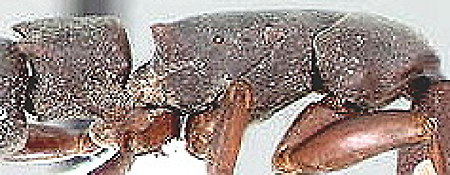 Opening of
propodeal spiracle round or oval Opening of
propodeal spiracle round or oval |
2 |
| -- |  Opening of
propodeal spiracle elongate, slit-shaped Opening of
propodeal spiracle elongate, slit-shaped |
8 |
| 2 | Large, AL > 3.8 mm | 3 |
| -- | Smaller, AL < 3.8 mm | 4 |
| 3 | 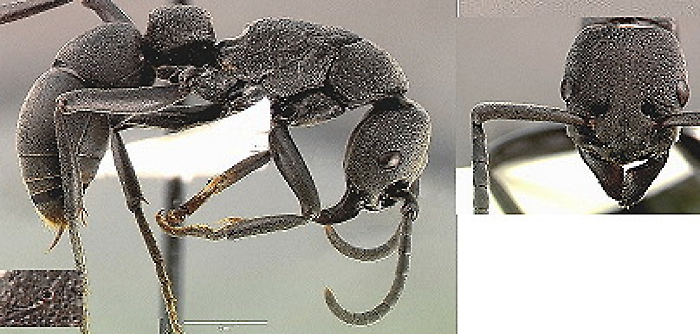 Petiole
with rounded node; TL 14-16.5 mm; dull black Petiole
with rounded node; TL 14-16.5 mm; dull black |
East Africa - cribrinodis |
| -- | 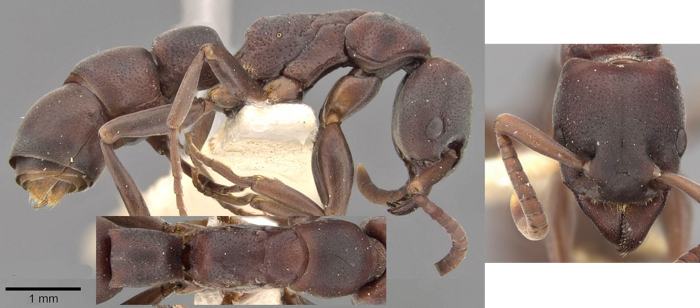 Dorsal
surfaces with no more than fine sculpturation, in parts shiny; coarse
puncturation small and shallow; petiole with distinctive flat-topped
node; TL 8.4 mm; black with reddish appendages Dorsal
surfaces with no more than fine sculpturation, in parts shiny; coarse
puncturation small and shallow; petiole with distinctive flat-topped
node; TL 8.4 mm; black with reddish appendages |
West Africa - frontalis |
| 4 |  Posterior
margin of petiole node unarmed; mandibles edentate; TL 6.5 mm;
brownish-blackmost of head and appendages more red Posterior
margin of petiole node unarmed; mandibles edentate; TL 6.5 mm;
brownish-blackmost of head and appendages more red |
South Africa - cooperi |
| -- | Posterior margin of petiole node with 2-3 blunt teeth; mandibles distinctly toothed | 5 |
| 5 |  TL 5.5 mm plus;
HW 1.1-1.25 mm in full face
view (Brown key wrong on this); eye length about 0.22 HW, scapes just
reach the occipital margin of
head; black with lower legs ferruginous TL 5.5 mm plus;
HW 1.1-1.25 mm in full face
view (Brown key wrong on this); eye length about 0.22 HW, scapes just
reach the occipital margin of
head; black with lower legs ferruginous |
Cameroun - tenuis |
| -- | HW > 1.0 mm in full face view, scapes at least slightly exceeding posterior margin of head | 6 |
| 6 |  TL 7-9 mm; funiculus
segment 2 about twice as long as segment 3 and
much longer than the eye; eye small; posterior margin of petiole with
sharp, angular teeth; black appendages brownish red TL 7-9 mm; funiculus
segment 2 about twice as long as segment 3 and
much longer than the eye; eye small; posterior margin of petiole with
sharp, angular teeth; black appendages brownish redNote: the worker described by Arnold (1954) differs and may be a separate species |
West Africa & Congo Basin - occidentalis |
| . |
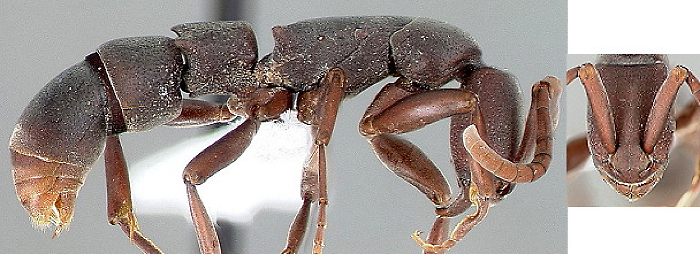 TL ca 7.6 mm (Arnold 7.0 mm) HW 1.35 HL 1.6 SL 1.1 PW
09.5 EL 0.2. Head relatively shorter and with weakly convex
sides; petiole also with more convex sides in dorsal view but
flat-tooped rather than shallowly domed. With more specimens it
seems likely that Arnold described the worker of a distinct species
separate from occidentalis.
Notable is the lack of the puncturation that is present on the whole of
the Liberia worker (above). TL ca 7.6 mm (Arnold 7.0 mm) HW 1.35 HL 1.6 SL 1.1 PW
09.5 EL 0.2. Head relatively shorter and with weakly convex
sides; petiole also with more convex sides in dorsal view but
flat-tooped rather than shallowly domed. With more specimens it
seems likely that Arnold described the worker of a distinct species
separate from occidentalis.
Notable is the lack of the puncturation that is present on the whole of
the Liberia worker (above). |
Uganda
specimen |
| -- | Funiculus segment 2 about same length as that of 3 and much shorter than the eye | 7 |
| 7 | 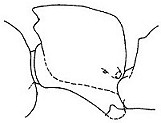 Posterodorsal
margin of petiole with a sharp margin that includes the two lateral
teeth; TL 6.6-7.0 mm; generally black with grey pubescence, appendages
red-brown Posterodorsal
margin of petiole with a sharp margin that includes the two lateral
teeth; TL 6.6-7.0 mm; generally black with grey pubescence, appendages
red-brown |
. |
| . | 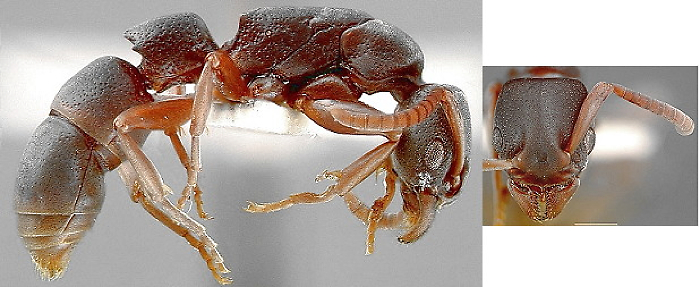 |
Panafrican forests - modesta |
| -- |  Posterodorsal margin of petiole more or less rounded
between lateral teeth and base of mandible with a conspicuous
dorsolateral grove; sculpture opaque with numerous conspicuous
punctures on the petiole and other dorsal surfaces; TL 8.5-9.5 mm;
black front of head and appendages red Posterodorsal margin of petiole more or less rounded
between lateral teeth and base of mandible with a conspicuous
dorsolateral grove; sculpture opaque with numerous conspicuous
punctures on the petiole and other dorsal surfaces; TL 8.5-9.5 mm;
black front of head and appendages red |
. |
| . |  |
Southern Africa - schultzei |
| . | Opening of propodeal spiracle elongate, slit-shaped | . |
| 8 | 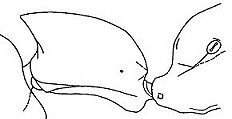 Eyes
small, no wider than scape; petiole node with sharp projecting
posterodorsal margin; TL 9.0-10.7 mm; overall black, appendages and
first gastral segment red; remainder of gaster yellow Eyes
small, no wider than scape; petiole node with sharp projecting
posterodorsal margin; TL 9.0-10.7 mm; overall black, appendages and
first gastral segment red; remainder of gaster yellow |
. |
| . |  |
West Africa & Congo Basin - gracillima |
| -- | Eyes much longer than width of scape; petiole with posterodorsal margin no more than weakly projecting | 9 |
| 9 | 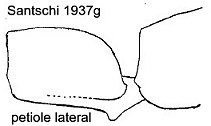 Posterior face of petiole node concave, sharply distinct
from dorsum, with weakly overhanging border; mesonotum not impressed;
TL 11.8-13.5 mm; black, mandibles castaneous red Posterior face of petiole node concave, sharply distinct
from dorsum, with weakly overhanging border; mesonotum not impressed;
TL 11.8-13.5 mm; black, mandibles castaneous red |
. |
| . |  |
Zimbabwe & Zaïre - arnoldi |
 Seemingly identical to arnoldi Seemingly identical to arnoldi |
Tanzania - viehmeyeri | |
| -- | Posterior face of petiole flat to convex, continuing from rounded dorsum; mesonotum often impressed | 10 |
| 10 | 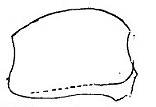 Petiole
node long and narrow; mesonotum distinctly impressed over whole length;
TL 12.5 mm; black but dull and pruinose, appendages more brown,
mandibles and tarsi red Petiole
node long and narrow; mesonotum distinctly impressed over whole length;
TL 12.5 mm; black but dull and pruinose, appendages more brown,
mandibles and tarsi red |
. |
| . |  |
southern Africa - lamellosa |
| -- | Petiole node not so long and narrow; mesonotum not hardly impressed | 11 |
| 11 | 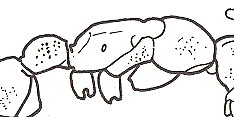 Larger,
AL > 3.8 mm; TL ca 12.5 mm; generally black but with dull grey
appearance due to dense pubescence, extremities red-brown Larger,
AL > 3.8 mm; TL ca 12.5 mm; generally black but with dull grey
appearance due to dense pubescence, extremities red-brown |
. |
| . | 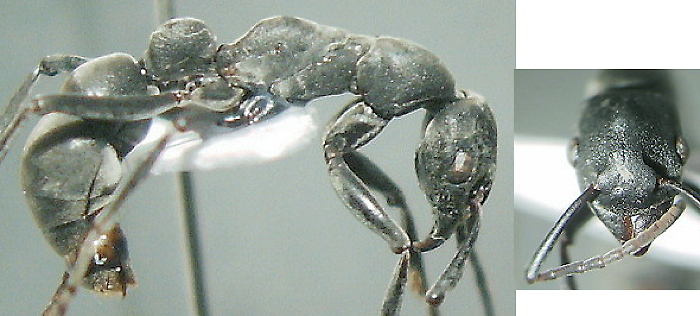 |
West Africa - conradti |
| -- |  Smaller AL < 3.8 mm; TL 7.5 mm; pruinose black Smaller AL < 3.8 mm; TL 7.5 mm; pruinose black |
Angola - crucheti |
| PONERINAE Introduction |
© 2007, 2008, 2013, 2014, 2015, 2018 - Brian Taylor
CBiol
FRSB FRES 11, Grazingfield, Wilford, Nottingham, NG11 7FN, U.K. |
href="platythyrea.htm"